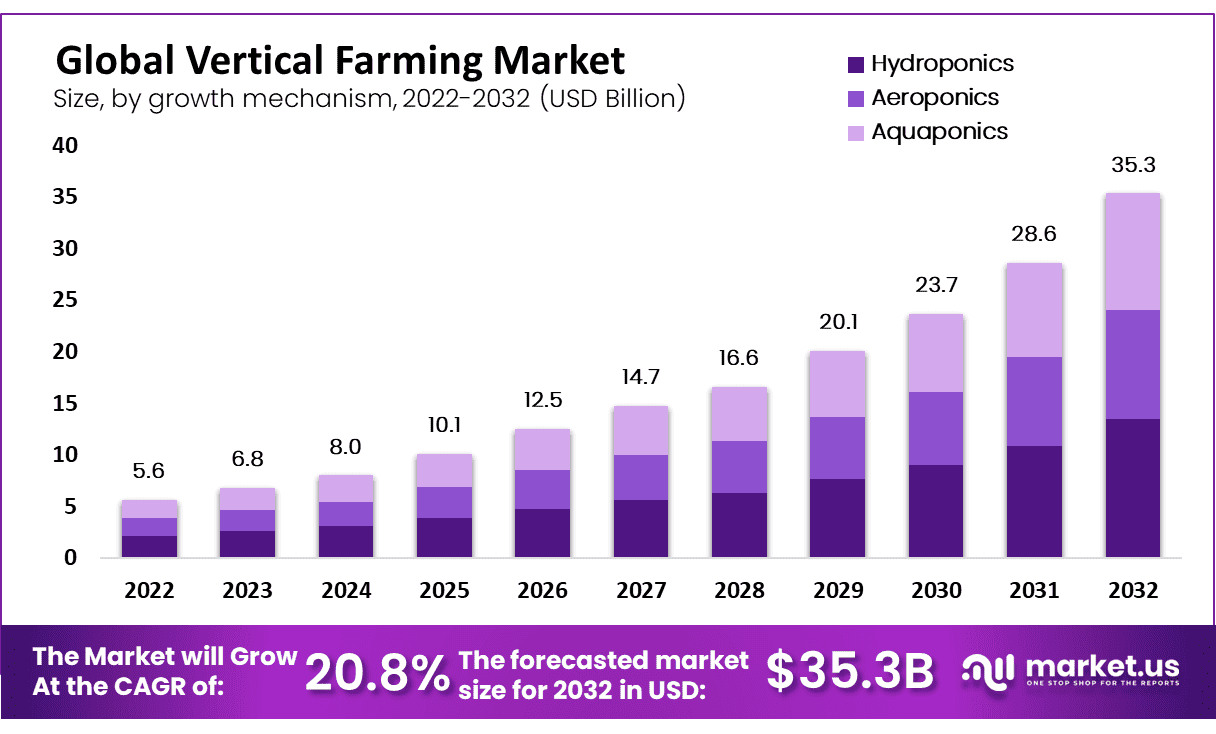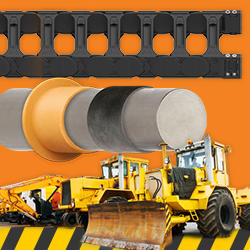Vertical Farming Market Size, Share | CAGR of 20.8%
Vertical Farming Market size is expected to be worth around USD 35.3 Billion by 2032 from USD 5.6 Billion in 2022, growing at a CAGR of 20.80% during the forecast period from 2023 to 2032.
Introduction
The global Vertical Farming Market is on a robust growth trajectory, expected to expand from USD 5.6 billion in 2022 to approximately USD 35.3 billion by 2032, growing at a compound annual growth rate (CAGR) of 20.8%. This surge is primarily driven by the increasing need for sustainable agricultural practices amidst declining arable land and the urban population's rising demand for fresh produce.
Several factors contribute to this growth, including advancements in technologies such as hydroponics and aeroponics, which allow crops to be grown using mineral nutrient solutions in water, without soil, thereby reducing the market's dependence on arable land. These methods not only enhance crop yield and speed up production but also significantly cut water usage by recycling much of the water in closed systems.
Key Takeaways
- Market Growth: The global Vertical Farming Market is projected to grow at a remarkable CAGR of 20.80% from 2023 to 2032. The market size is expected to reach USD 35.3 billion by 2032, a substantial increase from USD 5.6 billion in 2022.
- Water and Land Efficiency: Vertical farming is a water-saving solution, reducing water usage by about 90% compared to traditional farming. It also minimizes land surface disturbance, making it a more environmentally friendly option.
- Growth Mechanisms: Hydroponics is the dominant growth mechanism in vertical farming, accounting for 38% of the market share in 2022. It offers higher yield, ease of operation, and lower installation costs.
- Lighting System Dominance: Among the components used in vertical farming, lighting systems hold the largest market share at 32% in 2022. These systems provide the necessary light for plant growth and reduce operational costs.
- Regional Analysis: North America holds a major share of the global vertical farming market, with the largest market share of 35% in 2022.

Vertical Farming Statistics
- Vertical farming yields 50-100 times more produce per square foot than traditional farming.
- Greenhouse farming offers 10-12 times higher yields compared to traditional methods.
- Vertical farming: Up to 100 times higher yield per square foot.
- Greenhouse farming: Provides 10-12 times more yield than traditional methods.
- The food innovation market could reach $700 billion by 2030, a 5x increase from $135 billion today.
- In 2016, there were 2.3 million sq. ft. of indoor farms, expected to grow to 8.5-16.5 million by 2021.
- The global vertical farming market was $1.5 billion in 2016, projected to hit $6.4 billion by 2023.
- The Hanging Gardens of Babylon over 2,500 years ago are among the earliest indoor farms.
- Indoor farming is 170x more productive than outdoor fields.
- Indoor lettuce farming has 4x more crop turns annually than outdoor growers.
- Indoor growers yield 10-15x more than outdoor farms.
- Hydroponics, used in indoor farming, consumes 90% less water.
- Foodborne illnesses cost nearly $15.6 billion annually in the US alone.
- AeroFarms invested $42 million to build the world's largest indoor farm.
- The vertical farming sector grew by over 24% from 2018 to 2024.
- Japan leads in indoor farming, with 200 large-scale factories.
- Vertical farming saves up to 90% of space.
- Automation and safer work environments reduce labor expenses by 30% compared to traditional farms.
Emerging Trends
- Technological Integration: Vertical Farming Market is increasingly harnessing technologies like artificial intelligence (AI), the Internet of Things (IoT), and advanced robotics. AI and IoT are crucial for optimizing plant growth by analyzing data on environmental conditions and enhancing resource management. This includes precise control over nutrients, water usage, and monitoring plant health, leading to increased efficiency and higher yields.
- Sustainability Focus: There is a strong emphasis on sustainable practices within vertical farming. Innovations aim to reduce water use significantly, with systems that recycle water efficiently. Moreover, the use of renewable energy sources is gaining traction, minimizing the carbon footprint of vertical farms.
- Crop Diversification: There's a move towards diversifying the types of crops grown in vertical farms. Beyond leafy greens and herbs, some farms are exploring the cultivation of a broader range of vegetables and even fruits, tailored to specific culinary needs or consumer preferences. This trend is partly driven by the ability of vertical farms to quickly adapt to market demands and grow crops that are otherwise out of season.
- Hyper-localization: Vertical farms are increasingly being integrated into urban settings where they can produce food close to consumers. This not only reduces transportation costs and emissions but also ensures fresh produce is more readily available to urban populations. This approach is also seen as a method to combat food deserts by providing fresh produce directly in food-scarce areas.
- Increased Investments: The sector is attracting significant investment, which is driving rapid growth and innovation. Startups and established companies alike are receiving funding to expand their operations and explore new technologies, which is expected to continue driving the industry's growth and technological advancement.
Use Cases
- High-Efficiency Crop Production: Vertical farms utilize controlled environments to maximize yield per square foot, allowing for multi-layered crop production. This system is highly efficient, using technologies such as hydroponics and aeroponics, which require less water than traditional farming methods. The integration of advanced lighting, climate control, and nutrient delivery systems ensures optimal plant growth conditions throughout the year.
- Enhanced Quality and Safety: By controlling the growing environment, vertical farms can produce crops that are free from pesticides and environmental contaminants. This is particularly beneficial for growing herbs, leafy greens, and vegetables that are directly consumed. The controlled conditions also help in maintaining consistent quality and taste.
- Sustainable Practices: Vertical Farming Market contributes to sustainable agricultural practices by significantly reducing the use of water, an essential feature in regions facing water scarcity. Additionally, the proximity of these farms to urban centers reduces transportation costs and carbon emissions, contributing to lower overall environmental impact.
- Customization for Specific Needs: The technology enables the cultivation of customized crops that can meet specific nutritional requirements or consumer preferences. This is particularly valuable for premium markets or specialized dietary needs, where buyers are looking for specific attributes in their produce.
- Research and Development: Vertical farms offer a controlled environment that is ideal for agricultural research and development. Researchers can manipulate conditions to study different aspects of plant biology, crop yields, and growing techniques, which can be crucial for developing new agricultural technologies and practices.
- Commercial and Residential Applications: Beyond large-scale commercial operations, vertical farming technologies are also being adapted for smaller scales, including residential and community-based projects. This adaptability makes it possible to implement vertical farming solutions in a variety of settings, promoting local food production even in non-traditional agricultural spaces.
Key Players Analysis
AeroFarms is a pioneering leader in the vertical farming industry, known for its innovative approach to indoor agriculture. Founded in 2004 and headquartered in Newark, New Jersey, AeroFarms specializes in growing a variety of crops using aeroponic systems. Their technology allows them to produce crops with up to 95% less water and no pesticides, compared to traditional farming methods. AeroFarms' controlled environment agriculture enables them to optimize plant health and productivity, making significant strides in food safety and sustainability. They are recognized as one of the most innovative companies, continually pushing the boundaries of agricultural technology to improve crop yields and reduce environmental impact. Additionally, AeroFarms has engaged in strategic partnerships with major companies like Cargill to explore further advancements in agriculture, such as optimizing cocoa production.
Sky Greens stands out as a pioneer in the vertical farming industry with its innovative low-carbon, hydraulic-driven vertical farming system. Founded in Singapore, Sky Greens was the world's first to employ this eco-friendly technology, which allows for the rotation of plant troughs to ensure equal light exposure, enhancing growth efficiency. The farm's unique A-frame design maximizes land use, enabling it to produce significantly more greens per unit area than traditional farms. This system not only optimizes the use of limited space but also conserves water and reduces energy consumption, aligning with sustainability goals. Sky Greens' commitment to providing fresh, safe, and delicious vegetables locally has set a benchmark in urban agricultural solutions, making a substantial impact on food security in land-scarce regions like Singapore.
American Hydroponics, often abbreviated as AmHydro, is a notable entity in the vertical farming industry, focusing on hydroponic systems. The company is a veteran in providing advanced hydroponic systems for efficient and sustainable crop production. They are particularly adept at optimizing space and resources in controlled environment agriculture, making them a go-to solution for businesses aiming to implement high-density, sustainable growing practices in urban settings. Their expertise not only enhances food production capabilities but also supports urban areas where traditional farming space is limited. Through their innovative systems, American Hydroponics plays a pivotal role in transforming urban agriculture by enabling year-round crop production with minimal water and space usage.
Conclusion
In conclusion, vertical farming is poised to redefine the landscape of agriculture by integrating advanced technologies and sustainable practices. As a market research analyst, it's evident that this method of farming represents a crucial innovation in addressing some of the most pressing challenges of our time, including food security, urbanization, and environmental sustainability. By optimizing space through the cultivation of crops in vertically stacked layers and employing techniques like hydroponics and aeroponics, vertical farming maximizes crop yields and minimizes resource usage. This approach not only enhances the efficiency of food production but also significantly reduces the water and land requirements compared to traditional farming methods.
Featured Product

igus® - Free heavy-duty plastic bearings sample box
The iglide® heavy-duty sample box provides a selection of five unique iglide bearings, each suitable for use in heavy-duty equipment due to their self-lubricating, dirt-resistant properties. Each bearing material boasts unique benefits and is best suited for different application conditions, though each can withstand surface pressures of at least 11,603 psi at 68°F.
